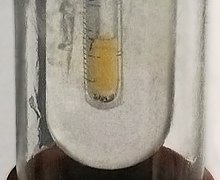Template:Infobox fluorine: Difference between revisions
Appearance
Content deleted Content added
Double sharp (talk | contribs) fixed |
Double sharp (talk | contribs) cut 2nd crystal structure per TCO. |
||
| Line 57: | Line 57: | ||
|crystal structure=monoclinic base-centered |
|crystal structure=monoclinic base-centered |
||
|crystal structure comment=alpha state (low-temperature)<ref name="phases">{{cite report|last=Young|first=David A.|publisher=Springer|title=Phase Diagrams of the Elements|page=10|year=1975|url=http://www.osti.gov/bridge/servlets/purl/4010212-0BbwUC/4010212.pdfaccess|accessdate=10 June 2011}}</ref> |
|crystal structure comment=alpha state (low-temperature)<ref name="phases">{{cite report|last=Young|first=David A.|publisher=Springer|title=Phase Diagrams of the Elements|page=10|year=1975|url=http://www.osti.gov/bridge/servlets/purl/4010212-0BbwUC/4010212.pdfaccess|accessdate=10 June 2011}}</ref> |
||
|crystal structure2=cubic |
|||
|crystal structure comment2=beta state (high-temperature) |
|||
|oxidation states=−1 |
|oxidation states=−1 |
||
|oxidation states comment=oxidizes oxygen |
|oxidation states comment=oxidizes oxygen |
||
Revision as of 04:22, 24 October 2013
 Liquid fluorine (F2 at extremely low temperature) | |||||||||||||||||||||
| Fluorine | |||||||||||||||||||||
|---|---|---|---|---|---|---|---|---|---|---|---|---|---|---|---|---|---|---|---|---|---|
| Pronunciation | |||||||||||||||||||||
| Allotropes | alpha, beta (see Allotropes of fluorine) | ||||||||||||||||||||
| Appearance | gas: very pale yellow liquid: bright yellow solid: transparent (beta), opaque (alpha) | ||||||||||||||||||||
| Standard atomic weight Ar°(F) | |||||||||||||||||||||
| Fluorine in the periodic table | |||||||||||||||||||||
| |||||||||||||||||||||
| Group | group 17 (halogens) | ||||||||||||||||||||
| Period | period 2 | ||||||||||||||||||||
| Block | p-block | ||||||||||||||||||||
| Electron configuration | [He] 2s2 2p5[3] | ||||||||||||||||||||
| Electrons per shell | 2, 7 | ||||||||||||||||||||
| Physical properties | |||||||||||||||||||||
| Phase at STP | gas | ||||||||||||||||||||
| Melting point | 53.48 K (−219.67 °C, −363.41[4] °F) | ||||||||||||||||||||
| Boiling point | 85.03 K (−188.11 °C, −306.60[4] °F) | ||||||||||||||||||||
| Density (at STP) | 1.696[5] g/L | ||||||||||||||||||||
| when liquid (at b.p.) | 1.505[6] g/cm3 | ||||||||||||||||||||
| Triple point | 53.48 K, 90[4] kPa | ||||||||||||||||||||
| Critical point | 144.41 K, 5.1724[4] MPa | ||||||||||||||||||||
| Heat of vaporization | 6.51[5] kJ/mol | ||||||||||||||||||||
| Molar heat capacity | (Cp) (21.1 °C) 31[6] J·mol−1·K−1 (Cv) (21.1 °C) 23[6] J/(mol·K) | ||||||||||||||||||||
Vapor pressure
| |||||||||||||||||||||
| Atomic properties | |||||||||||||||||||||
| Oxidation states | common: −1 | ||||||||||||||||||||
| Electronegativity | Pauling scale: 3.98[7] | ||||||||||||||||||||
| Ionization energies |
| ||||||||||||||||||||
| Covalent radius | 64[8] pm | ||||||||||||||||||||
| Van der Waals radius | 135[9] pm | ||||||||||||||||||||
| Other properties | |||||||||||||||||||||
| Natural occurrence | primordial | ||||||||||||||||||||
| Crystal structure | base-centered monoclinic alpha state (low-temperature)[10] | ||||||||||||||||||||
| Thermal conductivity | 0.02591[11] W/(m⋅K) | ||||||||||||||||||||
| Magnetic ordering | diamagnetic, −1.2×10−4 (SI)[12][13] | ||||||||||||||||||||
| CAS Number | 7782-41-4[7] | ||||||||||||||||||||
| History | |||||||||||||||||||||
| Naming | after the mineral fluorite, itself named after Latin fluo (to flow, in smelting) | ||||||||||||||||||||
| Discovery | André-Marie Ampère (1810) | ||||||||||||||||||||
| First isolation | Henri Moissan[7] (June 26, 1886) | ||||||||||||||||||||
| Named by | Humphry Davy | ||||||||||||||||||||
| Isotopes of fluorine | |||||||||||||||||||||
| |||||||||||||||||||||
References
- ^ "Standard Atomic Weights: Fluorine". CIAAW. 2021.
- ^ Prohaska, Thomas; Irrgeher, Johanna; Benefield, Jacqueline; Böhlke, John K.; Chesson, Lesley A.; Coplen, Tyler B.; Ding, Tiping; Dunn, Philip J. H.; Gröning, Manfred; Holden, Norman E.; Meijer, Harro A. J. (2022-05-04). "Standard atomic weights of the elements 2021 (IUPAC Technical Report)". Pure and Applied Chemistry. doi:10.1515/pac-2019-0603. ISSN 1365-3075.
- ^ Jaccaud et al. 2000, p. 381.
- ^ a b c d Haynes, William M., ed. (2011). CRC Handbook of Chemistry and Physics (92nd ed.). Boca Raton, FL: CRC Press. p. 4.121. ISBN 1-4398-5511-0.
- ^ a b Aigueperse et al. 2005, "Fluorine", p. 2.
- ^ a b c Compressed Gas Association (1999). Handbook of compressed gases. Springer. p. 365. ISBN 9780412782305.
- ^ a b c d Aigueperse et al. 2005, "Fluorine", p. 1.
- ^ Dean 1999, p. 4.35.
- ^ Kim, Sung-Hoon (2006). Functional dyes. Elsevier. p. 257. ISBN 9780444521767.
- ^ Young, David A. (1975). Phase Diagrams of the Elements (Report). Springer. p. 10. Retrieved 10 June 2011.
- ^ Yaws & Braker 2001, p. 385.
- ^ Mackay, Mackay & Henderson 2002, p. 72.
- ^ Cheng, H.; Fowler, D. E.; Henderson, P. B.; Hobbs, J. P.; Pascaloni, M. R. (1999). "On the magnetic susceptibility of fluorine". Journal of Physical Chemistry A. 103 (15): 2861–2866. doi:10.1021/jp9844720.
- ^ Chisté & Bé 2011.
- ^ a b c Dean 1999, p. 4.6.
- ^ Chiste, V. (2006). "F-18" (PDF). Table de radionucleides. Laboratoire National Henri Becquerel. Retrieved 15 June 2011.
{{cite web}}: Unknown parameter|coauthors=ignored (|author=suggested) (help)

